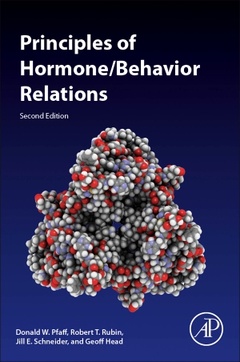Description
Principles of Hormone/Behavior Relations (2nd Ed.)
Authors: Pfaff Donald W., Rubin Robert T, Schneider Jill E., Head Geoff
Language: English
Subjects for Principles of Hormone/Behavior Relations:
Keywords
Acetylation; Addison; Adipose tissue; Adrenal gland; Adrenal hyperplasia; Adrenal insufficiency; Affiliation; Aggression; Aging; Androgen decline; Androgens; Angiotensin; Anorexigenic; ANP; Appetition; Arginine vasopressin; Arousal; Atrial natriuretic peptide; Biological clock; Brain development; C; elegans; Castration; Chromatin; Circadian rhythm; Circadian; Classical genomic action; Clock genes; Combinations; Cortisol; Courtship; CRH; Cushing; Depression; Development; Diabetes insipidus; Diabetes; Dihydrotestosterone; Diurnal; Drinking; Duration; Dysphoria; Endocrine disruption; Energy availability; Environment; Estradiol; Estrogen receptor; Estrogen; Estrogens; Evolution; Female; GABA; Gene duplication; Gene splicing; Gene; Ghrelin; GnRH; Gonads; Graves; Growth hormone; Hormone deficiency; Hormone excess; HPG system; Hyperthyroid; Hypothalamus; Hypothyroid; Infradian rhythm; Ingestion; Ingestive behavior; Insulin; Leptin; Ligand-independent; Lordosis; Major depression; Male; Maternal separation; Melatonin; Memory loss; Menopause; Methylation; Microbiome; Molecular phylogeny; Monogamy; Motivation; Necessary; Neuraxis; Neuroendocrine; Neuroprotection; Nocturnal; Nonclassical genomic action; Nonclassical nongenomic action; NPY; NYY; Orexigenic; Osmoregulation; Ovarian development; Ovariectomy; Ovulation; Pacing; Partner preference; Per gene; Pheromones; Pineal gland; Pituitary; Precocious puberty; Precopulatory behavior; Priming; Progestin receptor; Progestins; Prolactin; Pro-opiomelanocortin; Puberty; Remove-and-replace; Reproduction; Reproductive hormones; Reproductive system; Retina; Rhythms; Ring dove; Salt appetite; Satiation; Seasons; Sex behavior; Sex differences; Sexual dimorphism; Sexual reward; Socioeconomic status; Splanchnic nerve; SRY gene; Steroid receptor; Steroid synthesis; Stress; Sufficient; Suprachiasmatic nucleus; Testosterone; Thirst; Thyroid gland; Transcribe; Transsexual; Trauma; Ultradian rhythm; Vagus nerve; Vasopressin
77.27 €
In Print (Delivery period: 14 days).
Add to cartSupport: Print on demand
Description
/li>Contents
/li>Readership
/li>Biography
/li>Comment
/li>
Principles of Hormone/Behavior Relations, Second Edition, provides an introduction to the underlying principles of endocrine regulation of behavior, a newly emerging area of research within neurobiology and endocrinology. It addresses the properties of hormone/behavior relations, including the influence of family background, timing issues, neuroanatomical features, cellular mechanisms, and the importance of environmental context and evolution. This new edition incorporates critical advances in the field, also including increased coverage of hormonal influences on food intake, and on the cardiovascular system.
The addition of entirely new principles provides further coverage of epigenetics and appetite. Thoroughly revised and updated, this book is an ideal resource for neuroscientists and researchers engaging in this rapidly expanding field of study.
Section I: Characterizing the Phenomena: Hormone Effects are Strong and Reliable1. Hormones Can Both Facilitate and Repress Behavioral Responses2. One Hormone Can have Many Effects: A Single Hormone Can Affect Complex Behaviors3. Hormone Combinations Can be Important for Influencing an Individual Behavior4. Hormone Metabolites Can be the Behaviorally Active Compounds5. There are Optimal Hormone Concentrations: Too Much or Too Little Can be Damaging6. Hormones Do Not ‘‘Cause’’ Behavior; They Alter Probabilities of Responses to Given Stimuli
Section II: History: Hormone Effects Can Depend on Family, Gender, and Development7. Familial/Genetic Dispositions to Hormone Responsiveness Can Influence Behavior8. The Sex of the Recipient can Influence the Behavioral Response9. Hormone Actions Early in Development Can Influence Hormone Responsiveness in the CNS During Adulthood10. Puberty Alters Hormone Secretion and Hormone Responsivity and Heralds Sex Differences11. Changes in Hormone Levels and Responsiveness During Aging Affect Behavior
Section III: Time: Hormonal Effects on Behavior Depend on Temporal Parameters12. Duration of Hormone Exposure Can Make a Big Difference: In Some Cases Longer is Better; In Other Cases Brief Pulses are Optimal for Behavioral Effects13. Hormonal Secretions and Responses are Affected by Biological Clocks
Section IV: Space: Spatial Aspects of Hormone Administration and Impact are Important14. Effects of a Given Hormone Can be Widespread Across the Body; Central Effects Consonant with Peripheral Effects Form Coordinated, Unified Mechanisms15. Hormones Can Act at All Levels of the Neuraxis to Exert Behavioral Effects; The Nature of the Behavioral Effect Depends on the Site of Action
Section V: Mechanisms: Molecular and Biophysical Mechanisms of Hormone Actions Give Clues to Future Therapeutic Strategies16. In Responsive Neurons, Rapid hormone Effects Can Facilitate Later Genomic Actions17. Gene Duplication and Splicing Products for Hormone Receptors in the CNS Often Have Different Behavioral Effects18. Hormone Receptors and Other Nuclear Proteins Influence Hormone Responsiveness
Section VI: Environment: Environmental Variables Influence Hormone/Behavior Relations19. Hormone Effects on Behavior Depend Upon Context20. Behavioral/Environmental Context also Alters Hormone Release
Section VII: Evolution21. Neuroendocrine Mechanisms Have Been Conserved to Provide Biologically Adaptive Body/Brain/Behavior Coordination
VA Greater Los Angeles Healthcare System, Los Angeles, CA, USA
Professor Jill E. Schneider has been teaching undergraduate courses in Behavioral Endocrinology and other topics in neuroscience at Lehigh University for over 25 years. She received graduate and postdoctoral training in biology and neuroscience at Wesleyan University and the University of Massachusetts, respectively, and was awarded the Frank A. Beach Award from the Society for Behavioral Neuroendocrinology for outstanding research in behavioral neuroendocrinology in 1991. Professor Schneider’s National Science Foundation-funded neuroendocrinology laboratory is focused on metabolic and hormonal mechanisms at the interface of reproductive and ingestive behavior.
- Provides a unique structure where each chapter addresses a key principle that is illustrated by numerous basic experimental and clinical examples
- Includes user-friendly features, such as boxed figures with extended captions and references, numerous clinical notes, and a comprehensive list of abbreviations
- Contains numerous illustrations that highlight both the clinical and basic science information




